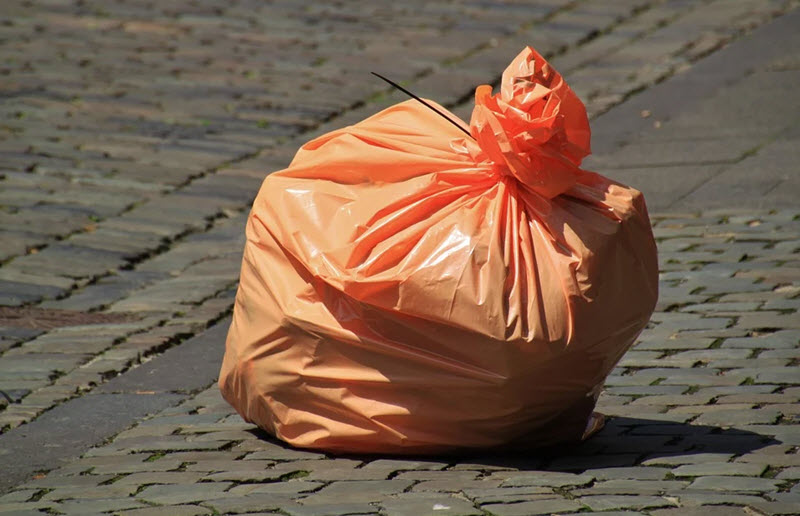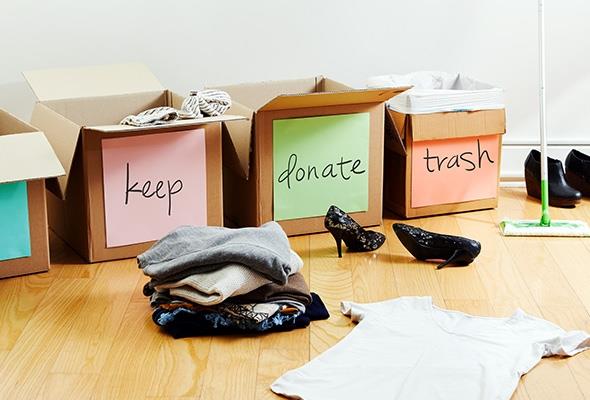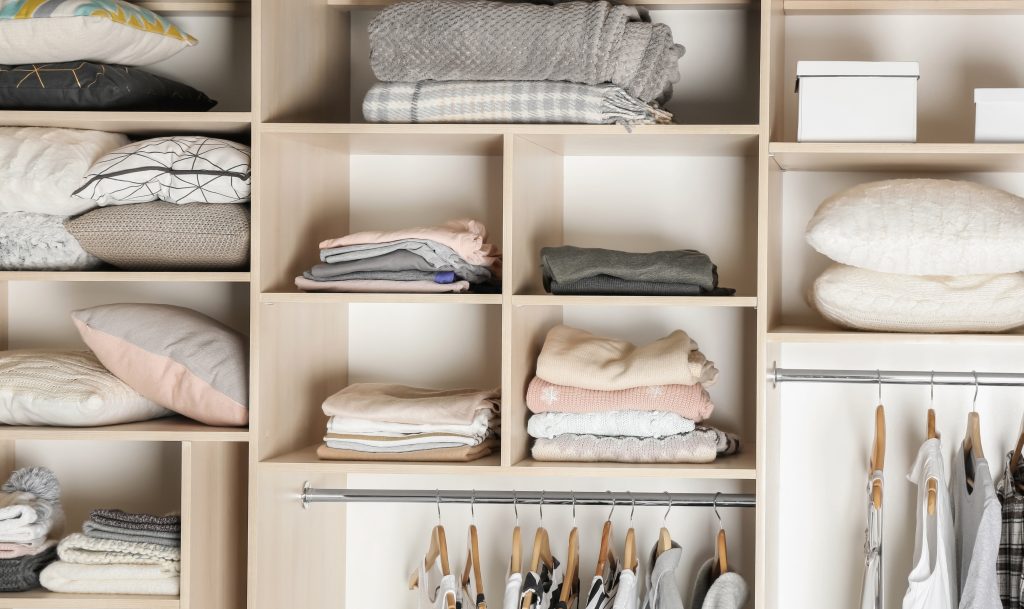If you live with more people, you will also need to ask your room mates or family members to adopt the new habits.
If you don’t work this out with other members of your household, your efforts to organize and tidy up will probably be over shadowed by the accumulation of other people’s stuff.
Ordering is not just an activity, it’s a lifestyle, so you can only keep the mess at bay if you lead an organized lifestyle. Some advice:
- Set a regular time to order, preferably once a week or every two weeks.
- Get rid of anything that has not been used in the last year.
- Throw away, recycle or donate what you do not need (but above all donate and recycle).
1. Change your perspective
One of the reasons it’s so hard to deal withthe disorder is that most people stop paying attention to it after a short time. When a room or an entire house is in disarray for a long time, many people become immune to the problem. Somepeople even forget what that part of their house looked like before it got messy. In other words, the disorder becomes common in the environment.
To recognize the magnitude of the problem, most people need the perspective of someone from the outside, so tell your parents, trusted friend or neighbor to take a look at every room in your house and ask them for advice. Examine eachshelf, cupboard or storage area and, while you are checking out the stuff, ask questions. For example:
- How would you orginize this?
- What would you throw away?
- What do you think is the best organizational system for this space?
These questions will help you get ideas to advance your efforts to put things in order.

2. Ask yourself the right questions
Even if you’re checking out your homealone, it is important to ask yourself questions as you evaluate your items and make a plan to move forward.
¿Do I really need it?
Most people hold on to things they do not need for different reasons. People associate memories with objects, and sometimes they keep them because throwing away those objects would be like throwing away the memory. However, it is important to realize that these objects are not memories, but that the memories are retained even after the objects have disappeared.
In addition, many people cling to objects out of concern that one day they may need them again. When ordering, it is useful to note that if an object has not been used for one year, it will not be needed in the future.
Can I trade this for inner peace?
This is a very powerful question, because disorder makes calm disappear and preserving things is the equivalent of replacing peace with them. During the process of putting the house in order, many people find it helpful to think about the relationship between disorder and inner peace by asking themselves this question.
3. Create a routine
Organizational routines should not betiring. Make it a daily habit to tidy up and spend more time periodically tidying up at various times of the year.
Daily order
Identify the parts of the house that aremost easily disturbed (the children’s play area, for example), and collect those a reaseach day. Check your mail every day. Keep what you need and recycle what you don’t.
Quarterly order
Take time once every three months to thoroughly clean a different area of the house each time. The areas that should normally be addressed on a quarterly basis are:
- Garage
- Attic
- Basement
- Cabinets
- Storage areas
- Guest room
Establish a plan at the beginning of the year to ensure that your home will be tidied up as needed. If the quarterly order is not enough, do it monthly, until the whole house is clean and organized.

4. Tips and strategies for organizing the house
That is the theory, and I am sure you noddedas you read. Putting it into practice, it is not always that easy. Let’s hope some of the strategies work for you.
4.1. Make task lists
Once you have assessed the clutter in your house, make a to-do list. Divide your houseinto zones and make a list of tasks to be carried out in each of them.
Then decide how long it will take you to complete each zone and when you will finish each one. Extend the list of tasks to the entire calendar so that by the end of the year every part of your house should be fully organized.
4.2. Take care of the mail right away
Mailing papers pile up easily, so take care of them every day. Throw away or recycle what you don’t need to get anymore. For what you do need, choose a place to leave it where it won’t get lost or forgotten and buy a mail organizer to put the papers inside. The organizer you buy should have different slots for different types of mail, such as invoices, coupons, advertising, etc, and put labels for each category.
Order the organizer at the end of the weekand teach your family or flatmates how touse it. It is the only way to prevent it from getting out of order and therefore not being useful anymore.
4.3. Fill one garbage bag a day
This idea of thorough cleaning is useful for anyone who wants to get rid of junk quickly. It starts every day by opening boxes, checking shelves, washing laundry and tidying cupboards. When you have filled atrash bag, cleanup day is over.
This short-term cleaning plan is a good way to organize a house when the deadline approaches. For example, when guests are expected, or when the house is to be put up for sale, this method is quick and effective without being overly burdensome.
Carry out this method if you have a lot of junk to dispose of. For example, if you have a garage, a loft, a basement or a room that has become a storage room over the years. People who use this method are often those who have lived in the same house for many years and have let things accumulate for a long time.

4.4. Throw away or donate an item each day
During the time you spend each day ordering, identify an object to throw away or donate. This method doesn’t get rid of junk very quickly, but it is a good way to avoid accumulating junk in the long run.
Who should use this method?
People who use this method do not have a big problem with accumulation of things and do not need to get rid of them quickly, but rather those who normally already keep a well ordered house. Doing this allows them to prevent the disorder from becoming a problem.
4.5. Use the”four box” method
This method can be useful for organizing any space, such as a shelf, a closet or a bedroom. To begin with, get four medium (or large depending on the size of the space you are going to organize) boxes and label them as follows:
- Preserve. In this box you keep anything you want to keep.
- Doubtful. This box will hold any item you are not sure about whether you want to keep it or what you want to do with it.
- Throw. Put in it whatever you decide to throwaway.
- Donate. Deposit whatever you can donateinto it. This box can also be a miscellaneousbox, with things to break, recycle, etc.
After labeling the four boxes, place the corresponding objects in them. When the boxes are full, take time to put away the items in the “Keep”; box, throw away everything in the”Throw away”; box, etc. After deciding what to keep and whatto throw away, it is easier to decide what todo with the items in the “Doubtful”; box.

4.6. Take the “one month in a cardboardbox”; test
This test is a way to evaluate which everyday objects are necessary and which are not. It is normally used to arrange small spaces such as cupboards and drawers. Take everything in the tidy space and put itin a cardboard box. If you use any object in that box, put it back. In a month, what you have not used is not essential, so you should donate it or give it to your friends.
This test can be repeated in other parts of the house with clothes, decorations, etc. Carry out the test throughout the year in different areas of the house and by the end of the year you will have managed to remove a considerable amount of junk.
Memorize this four concepts
Memorize these concepts to help you stay organized and avoid clutter.
- Set up a dailytime and a quarterly schedule to eliminateclutter.
- Get rid of anything you haven’tused in a year or more.
- Return everything you have borrowed.
- Throw away or recycle anything you do not need.
These concepts are excellent recommendations for those who want to organize their home, but also a good practice for those who have alreadyorganized their home and want to keep that way.
Extra tips:
- Mark your calendar or diary with the days that are due for a quarterly cleanup.
- When you borrow something, like a book or a movie, put a reminder in your calendar or address book to return it.
- Recycle as much as you can while you are organizing.
- Keep in mind that some things can’t just be thrown away. There are many products such as paint or tires that should be taken to your local cleaners.
- Familiarize yourself with the schedules of your nearest clean point to bring your items closer whenever you need them.







